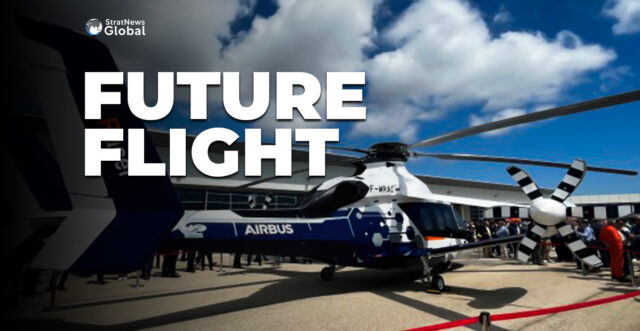MARIGNANE, FRANCE: Airbus Helicopters showcased an experimental half-plane, half-helicopter on Wednesday in a quest for speed as competition heats up to define the rotorcraft of the future.
With the imminent first flight of the 220 knot high technology Airbus Racer it’s time to ask: Is the conventional wisdom wrong? Are we going to see a return of the compound rotor?
Easy to fly, hybrid electric, super efficient, super fast. What’s not to like? pic.twitter.com/m2THohZmfw
— Jordan Taylor (@Jordan_W_Taylor) April 21, 2024
The 200 million euro ($217 million) Racer is a one-off demonstrator model combining traditional overhead rotors with two forward-facing propellers in a bid to combine stability and speed, shortening response times for critical missions like search-and-rescue.
“There are missions where the quickest possible access to the zone is vital. We often talk about the ‘golden hour’,” Airbus Helicopters CEO Bruno Even told Reuters, referring to the window considered most critical for providing medical attention.
Such designs could also be offered for military developments as NATO conducts a major study into next-generation helicraft, though much depends on how its planners define future needs.
The Racer, which first flew in April away from the cameras, buzzed past an audience of 150 industry executives, politicians and representatives from the European Union gathered at Airbus Helicopters’ base at Marignane, southern France, where it has been gradually taking shape over the past seven years.
Airbus, the world’s largest civil supplier, has for years been experimenting with new helicopter designs alongside rivals like Lockheed’s Sikorsky, which broke the then speed record with its X2 demonstrator helicraft over a decade ago.
The Racer is an all-new successor to the Dauphin-based X3 demonstrator which Airbus had revealed at a nearby air base in cloak-and-dagger secrecy in 2010, which went on to claim an unofficial record by pipping the Sikorsky X2 for speed.
Both designs aim to overcome obstacles to high-speed helicopter flight by combining the advantages of fixed-wing aircraft with those of a standard helicopter.
But there is no consensus on what the helicopter of the future will look like.
Racer’s public debut came months after Italy’s Leonardo and U.S. manufacturer Bell agreed to co-operate on the next generation of tilt-rotor technology, which replaces a helicopter’s trademark overhead blades altogether.
Leonardo is also leading a separate project to develop the next generation of tilt-rotors for civil use. Its AW609 is the sole existing civil design, but has yet to be certified.
Proponents of the tilt-rotor, which relies on swivelling side-mounted rotors 90 degrees to go up and then forwards, say it permits higher speed and range that are suited to military missions. Critics say the tilt mechanism reaches higher speeds only at the expense of higher complexity and maintenance costs.
Airbus said the Racer will fly at 220 knots (400 km/hour) compared with traditional helicopter speeds closer to 140 knots. Bell says its V-280 Valor tilt-rotor design, recently picked by the Pentagon, will reach a cruise speed of 280 knots.
(REUTERS)
















